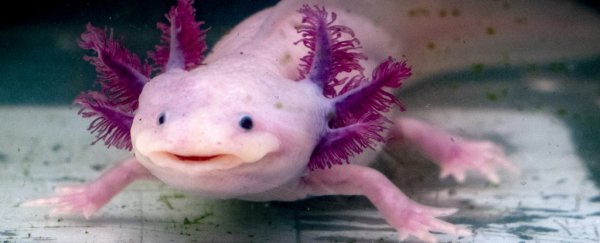In Aztec mythology, the god Xolotl was a symbol of many things: fire and lightning, but also dogs, sickness, and more. A melange of a deity, basically – and the strange salamander named after him is, aptly enough, an unusual hybrid too.
Axolotls (Ambystoma mexicanum), sometimes known as Mexican walking fish, are not actually fish at all, but amphibians, ones gifted with an amazing trait that borders on being a superpower: the ability to regenerate entire body parts if they go missing.
Other salamanders can replace lost limbs, but the axolotl's talents for regrowth may be unique. It can regenerate limbs, but also its tail, eyes, ovary and lung tissue, and spinal cord. Even whole sections of its brain and heart conveniently reappear, should they happen to disappear.
"It regenerates almost anything after almost any injury that doesn't kill it," says molecular biologist Grant Parker Flowers from Yale University.
In a new study, Flowers and fellow researchers have been investigating the genetic basis for this wondrous capability – a mystery that has intrigued scientists for years, but which could potentially lead to radical treatments for human injuries and diseases, if we can only unravel how the axolotl does its thing.
It is not, however, an easy puzzle to solve. In part that's because of the immense genetic complexity of the axolotl. Do not be fooled by that cute little face, and any good-natured cooperation it might seem to suggest.
In 2018, the axolotl's genome was sequenced in its entirety for the first time, revealing an enormous chain of code: the largest of any animal ever sequenced, and about 10 times larger than the human genome.
Despite the challenges presented, last year scientists broke new ground by identifying and mapping structures within this giant genome.
"Just a few years ago, no one thought it possible to assemble a 30+GB genome," one of the team, computational biologist Jeramiah Smith from the University of Kentucky, said at the time.
Now, in the new work by Flowers and colleagues, the researchers have identified genes they say are involved in the axolotl's tissue regeneration.
Building upon methods developed by the same team in 2017, in which the researchers quantified CRISPR/Cas9-generated mutations in the limbs of engineered axolotls, the group developed markers to track 25 genes suspected to be linked to limb regeneration.
In doing so, they identified two genes in axolotl blastema – the mass of cells involved in tissue regeneration – that appear to contribute to tail regrowth.
"Here, we provide a novel screening platform that couples targeted mutagenesis and lineage tracing to identify novel regulators of regeneration," the authors write in their paper.
"Using this approach, we find that catalase and fetuin-b are required for cells to participate in limb regeneration and for proper tail regeneration."
Of course, it's still early days in this kind of research, and the team acknowledges that many more genes are probably involved in regeneration – but nonetheless, it's a promising avenue for future research, which one day might enable humans to replicate some of the axolotl's impressive tricks.
The sad irony in all this is that for an animal whose signature move is its ability to regenerate, axolotl populations in the wild are on the verge of extinction in their native Mexican habitat, with a critically endangered status per the IUCN Red List, largely due to human causes.
In addition to borrowing whatever genetic secrets we can from this strange little creature, let us hope that conservation efforts can give them something equally valuable in return.
The findings are reported in eLife.
